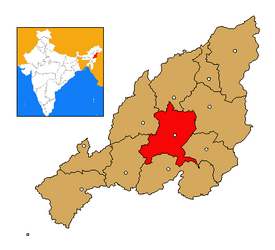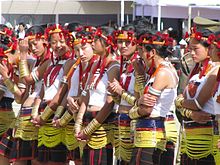Zunheboto (District)
| Zunheboto District | |
|---|---|

|
|
| State | Nagaland |
| Administrative headquarters : | Zunheboto |
| Area : | 1255 km² |
| Residents : | 140,757 (2011) |
| Population density : | 112 inhabitants / km² |
| Website : | www.zunheboto.nic.in |
Zunheboto is a district in the center of the northeast Indian state of Nagaland .
The area is 1255 km². The administrative seat is the city of the same name, Zunheboto .
population
According to the 2011 census, the Zunheboto district has 140,757 inhabitants. With 112 inhabitants per square kilometer, the district is densely populated. The district is rural. Of the 140,757 residents, 113,160 people (80.39%) live in rural areas and 27,597 people in urban communities.
The Zunheboto district is one of those areas of India that are almost entirely populated by members of the "tribal population" ( scheduled tribes ). (2011) 136,561 people (97.02 percent of the district's population) were among them. There is not a single Dalit ( scheduled castes ) in the district.
The population consists almost entirely of people who were born in the district. Of the residents, 136,282 people (96.82 percent of residents) were born in the district. A total of 1,607 people were born in other Indian states (including 594 people in Assam, 425 people in Bihar and 126 people in Manipur). Of the 87 foreign-born people, 70 are from Nepal.
Population development
As everywhere in India, the population in the Zunheboto District grew rapidly over decades. However, between 2001 and 2011 there was a decrease of 9 percent (8.95%). In those ten years the population fell by over 13,000 people. The following table illustrates the development:

Significant places
In the district there is only one place with more than 10,000 inhabitants with the district capital Zunheboto. The place of Satakha Hq. However, it is also considered a city (notified town).

District population by gender
As is common in India, the district always had more male than female residents. Among the youngest residents (under 7 years of age) the proportions are 51.34% male to 48.66% female.
| Distribution of the population by gender in Zunheboto District | ||||||||||||||
| 1961 census | 1971 census | 1981 census | 1991 census | 2001 census | 2011 census | |||||||||
| number | proportion of | number | proportion of | number | proportion of | number | proportion of | number | proportion of | number | proportion of | |||
| TOTAL | 44,624 | 100% | 56.202 | 100% | 72,878 | 100% | 96,535 | 100% | 154,598 | 100% | 140.757 | 100% | ||
| Men | 22,451 | 50.31% | 28,413 | 50.56% | 37.179 | 51.02% | 49,145 | 50.91% | 79,392 | 51.35% | 71,217 | 50.60% | ||
| Women | 22,173 | 49.69% | 27,789 | 49.44% | 35,699 | 48.98% | 47,390 | 49.09% | 75.206 | 48.65% | 69,540 | 49.40% | ||
District population by language
The population of Zunheboto District is linguistically uniform. The Zunheboto district is the core area of the Sumi (a Naga people). A clear majority of the population speaks this language. Since Sumi was not taken into account in the census, the Sumi simply stated Other as their mother tongue. The following table shows the languages given as mother tongue by more than 500 people:
| year | Other | Sema | Hindi | Bengali | Nepali | Ao | Yimchungre | Total | ||||||||
|---|---|---|---|---|---|---|---|---|---|---|---|---|---|---|---|---|
| number | % | number | % | number | % | number | % | number | % | number | % | number | % | number | % | |
| 2011 | 134.503 | 95.56 | 831 | 0.59 | 801 | 0.57 | 541 | 0.38 | 536 | 0.38 | 525 | 0.37 | 508 | 0.36 | 140.757 | 100.00% |
| Source: 2011 census result | ||||||||||||||||
Population of the district by confession
The Tibetan Burmese residents have converted almost entirely to Christianity in the past 100 years. The most important communities within Christianity are the Baptists, Presbyterians (Reformed), and Catholics. The Hindus and Muslims form small religious minorities and are mainly immigrants from other regions of India. The following table shows the exact religious composition of the population:
| year | Buddhists | Christians | Hindus | Jainas | Muslims | Sikhs | Other | not specified | Total | |||||||||
|---|---|---|---|---|---|---|---|---|---|---|---|---|---|---|---|---|---|---|
| number | % | number | % | number | % | number | % | number | % | number | % | number | % | number | % | number | % | |
| 2011 | 286 | 0.20 | 136.995 | 97.33 | 2,580 | 1.83 | 6th | 0.00 | 772 | 0.55 | 39 | 0.03 | 2 | 0.00 | 77 | 0.05 | 140.757 | 100.00% |
| Source: 2011 census result | ||||||||||||||||||
education
Thanks to significant efforts, literacy has risen sharply in recent decades. In urban areas, almost 95 percent of people can read and write. Around 83 percent can read and write in rural areas. The strong differences between the sexes and the urban / rural population are typical of Indian conditions.
| Literacy in the Zunheboto District | ||||||
| unit | 2011 census | |||||
| number | proportion of | |||||
| TOTAL | 102,881 | 85.26% | ||||
| Men | 53.504 | 87.85% | ||||
| Women | 49,377 | 82.62% | ||||
| TOTAL CITY | 22,732 | 94.50% | ||||
| City men | 12,127 | 95.51% | ||||
| City women | 10,605 | 93.36% | ||||
| TOTAL COUNTRY | 80.149 | 82.96% | ||||
| Country men | 41,377 | 85.84% | ||||
| Country women | 38,772 | 80.10% | ||||
| Source: 2011 census result | ||||||
economy
Agriculture is the dominant form of economy. The main crops grown include rice , corn and millet .
Administrative division
The district was divided into 13 circles at the last census in 2011.
| Population in the Circles | ||||||||||||||
| Aghunato | Akuhaito | Akuluto | Asuto | Atoizu | Ghathashi | Pughoboto | ||||||||
| number | proportion of | number | proportion of | number | proportion of | number | proportion of | number | proportion of | number | proportion of | number | proportion of | |
| TOTAL | 18,350 | 100% | 3,876 | 100% | 6,612 | 100% | 7,598 | 100% | 8,740 | 100% | 7,967 | 100% | 8,943 | 100% |
| Men | 9,072 | 49.44% | 1,988 | 51.29% | 3,408 | 51.54% | 3,876 | 51.01% | 4,320 | 49.43% | 3,984 | 50.01% | 4,454 | 49.80% |
| Women | 9,278 | 50.56% | 1,888 | 48.71% | 3,204 | 48.46% | 3,722 | 48.99% | 4,420 | 50.57% | 3,983 | 49.99% | 4,489 | 50.20% |
| city | 0 | 0% | 0 | 0% | 0 | 0% | 0 | 0% | 0 | 0% | 0 | 0% | 0 | 0% |
| country | 18,350 | 100% | 3,876 | 100% | 6,612 | 100% | 7,598 | 100% | 8,740 | 100% | 7,967 | 100% | 8,943 | 100% |
| Population in the Circles | ||||||||||||
| Saptiqa | Satakha | Satoi | Suruhuto | VK | Zunheboto Sadar | |||||||
| number | proportion of | number | proportion of | number | proportion of | number | proportion of | number | proportion of | number | proportion of | |
| TOTAL | 5.163 | 100% | 15,103 | 100% | 4,540 | 100% | 13,957 | 100% | 3,931 | 100% | 35,977 | 100% |
| Men | 2,496 | 48.34% | 7,796 | 51.62% | 2.263 | 49.85% | 7.209 | 51.65% | 2.006 | 51.03% | 18,345 | 50.99% |
| Women | 2,667 | 51.66% | 7,307 | 48.38% | 2,277 | 50.15% | 6,748 | 48.35% | 1.925 | 48.97% | 17,632 | 49.01% |
| city | 0 | 0% | 4,964 | 32.87% | 0 | 0% | 0 | 0% | 0 | 0% | 22,633 | 62.91% |
| country | 5.163 | 100% | 10.139 | 67.13% | 4,540 | 100% | 13,957 | 100% | 3,931 | 100% | 13,344 | 37.09% |

